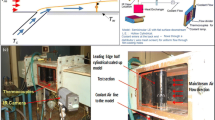Abstract
The blades in a gas turbine engine are exposed to extreme temperature levels that exceed the melting temperature of the material. Therefore, efficient cooling is a requirement for high performance of the gas turbine engine. The present study investigates film cooling by means of 3D numerical simulations using a commercial code: Fluent. Three numerical models, namely k-ε, RSM and SST turbulence models; are applied and then prediction results are compared to experimental measurements conducted by PIV technique. The experimental model realized in the ENSEMA laboratory uses a flat plate with several rows of staggered holes. The performance of the injected flow into the mainstream is analyzed. The comparison shows that the RANS closure models improve the over-predictions of center-line film cooling velocities that is caused by the limitations of the RANS method due to its isotropy eddy diffusivity.















Similar content being viewed by others
Abbreviations
- x, y, z:
-
Cartesian coordinates (mm)
- U:
-
Axial velocity component (m.s−1)
- V:
-
Vertical velocity component (m.s−1)
- T:
-
Temperature (°C)
- y+ :
-
Dimensionless value of y (mm)
- Ue :
-
Crossflow inlet velocity (m.s−1)
- Ui :
-
Injection flow velocity (m.s−1)
- D:
-
Diameter of the jet hole (mm)
- K:
-
Turbulent kinetic energy (m2.s−2)
- M:
-
Blowing ratio
- α:
-
Jet angle inclination (°)
- δ:
-
Boundary layer thickness (mm)
- \( {\ \upmu}_{\mathrm{t}} \) :
-
Eddy viscosity
- ω:
-
Dissipation frequency rate (s−1)
- \( {\mathrm{u}}^{\ast } \) :
-
Friction velocity (m.s−1)
- \( {\uptau}_{\mathrm{w}} \) :
-
Wall shear stress (kg.m.s−2)
- \( {\ \uprho}_{\mathrm{e}} \) :
-
Injection density flow (kg.m−3)
- \( {\ \uprho}_{\mathrm{i}} \) :
-
Main density flow (kg.m−3)
- ε:
-
Turbulent energy dissipation (m2.s−3)
References
Andreopoulos J, Rodi W (1984) Experimental investigation of jets in a cross-flow. J Fluid Mech 138:93–127
Fric TF, Roshko A (1989) Structure of Vorticity in the near field of the transverse jet. Tenth symposium on turbulent shear flows. Oxford University, Oxford
Dizene R (1993) Etude Expérimentale d’interaction de Jets avec un Ecoulement Transversal Compressible. Deuxième partie: Rangée de Jets Obliques. Thèse, CEAT, Université de Poitiers France
Ince NZ, Leschziner MA (1993) Comparison of three-dimensional jets in cross flow with and without impingement using reynolds stress transport closure. AGARD symposium on computational and experimental assessment of jets in crossflow
Demuren AO (1994) Modelling jets in cross flow, NASA Contractor Report 194965, ICASE. Report N°94–71, Contract NAS1–19480
Sen B, Schmidt DL, Bogard DG (1996) Film cooling with compound angle holes. Heat Transfer ASME J of Turbomachinery 118:800–806
Schmidt DL, Sen B, Bogard DG (1996) Film cooling with compound angle holes: adiabatic effectiveness. ASME J of Turbomachinery 118:807–813
Cho, H. H., Kim, B. G., Rhee, D. H, [1998], Effects of Hole Geometry on Heat (Mass)Transfer and Film Cooling E®ectiveness. Proceedings of 11th IHTC, Kyongju, Korea.
Yuen CHN, Martinez-Botas RF (2003) Film cooling characteristics of a single round hole at various stream wise angles in a cross flow. Part I effectiveness. Int J Heat Mass Transf 46:221–235
Gritsch M, Schulz A, Wittig S (1998) Adiabatic Wall effectiveness measurements of film-cooling holes with expanded exits. J Turbomach 120(3):549–556. doi:10.1115/1.2841752 History
Tyagi M, Acharya S (2003) Large eddy simulation of an inclined film cooling Jet 125:734–742
Guo et al (2004) Large-Eddy simulation of a jet in a crossflow. Volume 9 of the series ERCOFTAC. Series pp 603–610
Leedom D.H. (2009) Numerical Investigation of Film Cooling Fluid Flow and Heat Transfer using Large Eddy Simulations. B.S., Louisiana State University, May 2009.
Yao Y, Zhang J, Yang Y (2013) Numerical study on film cooling mechanism and characteristics of cylindrical holes with branched jet injections. Propulsion and Power Research 2(1):30–37
Balaji K et al (2016) Review of cooling effect on gas turbine blade. International conference on systems, science, control, communication, engineering and technology, vol 2. Karpagam Institute of Technology, Coimbatore, pp 478–482
Dey M, Prakhar J, Roy AK (2016) Numerical investigation of film cooling effectiveness in turbine blades. American Journal of Fluid Dynamics 6(1):20–26
Sun X, Peng W (2016) Effect of film cooling holes shape of helium turbine blades in HTGR, 24th international conference on nuclear engineering 2016; 6(1): 20–26, (2016) 24th international conference on nuclear engineering, Volume 3: thermal-hydraulics Charlotte, North Carolina, USA, June 26–30, 2016
Menter FR (1993) Zonal two equation k-ω turbulence models for aerodynamic flows. AIAA Paper 93–2906
Coles D (1956) he law of the wake in the turbulent boundary layer. J Fluid Mech 1:191–226. [Guggenheim. Aeronautical Lab., California Inst. Technology, Pasadena, CA]
Acknowledgements
The reported work was performed within the LMESC of the USTHB University research project “Aerothermal Investigation of Turbine Blades”. The present work was partially supported by ISAE-ENSMA Schools (P′ institute), University of Poitiers in France. The welcome received for conducting the experiments is gratefully acknowledged by the authors. The authors would like to warm fully acknowledge Prof. Eva Dorignac and Dr. Gildas Lalizel for their precious and fundamental support in this activity.
Author information
Authors and Affiliations
Corresponding author
Rights and permissions
About this article
Cite this article
Berkache, A., Dizene, R. Numerical and experimental investigation of turbine blade film cooling. Heat Mass Transfer 53, 3443–3458 (2017). https://doi.org/10.1007/s00231-017-2062-z
Received:
Accepted:
Published:
Issue Date:
DOI: https://doi.org/10.1007/s00231-017-2062-z




